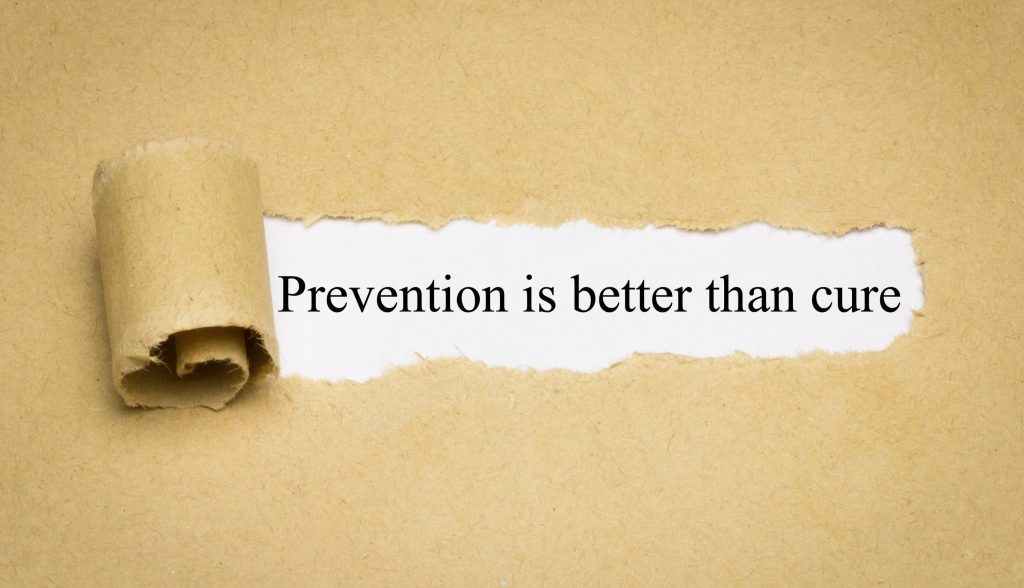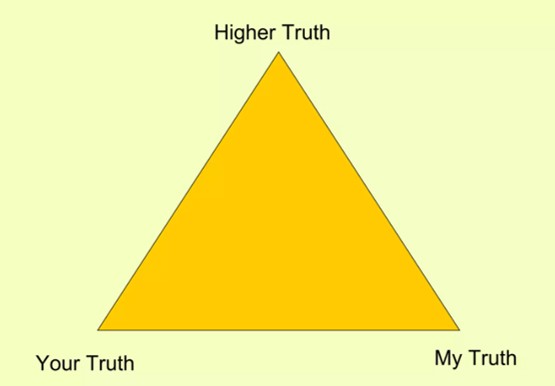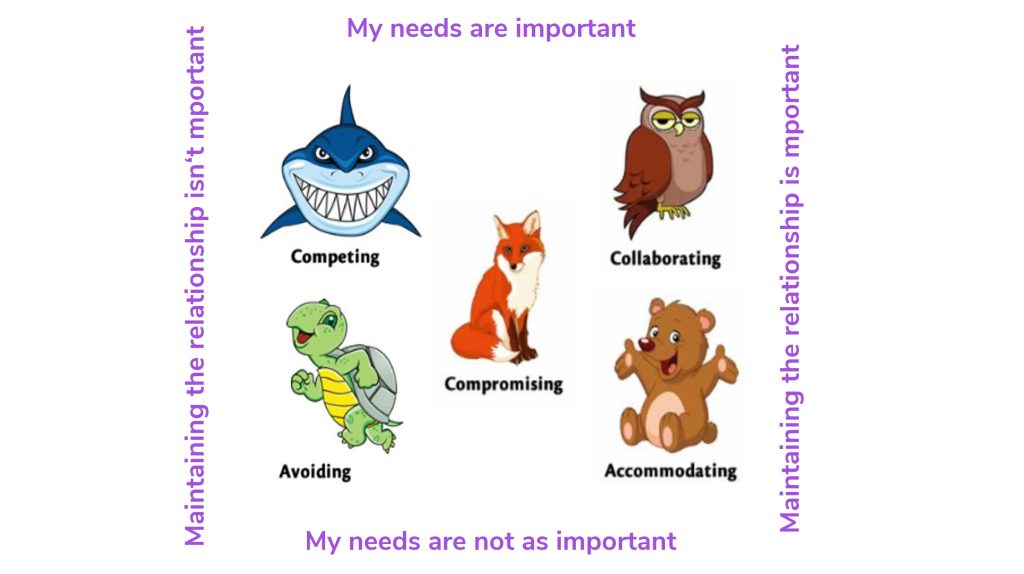
Managing interpersonal conflict in the workplace
Business Coaching
Many of you have probably experienced a tense situation with colleagues where you have snapped at each other, argued about a task, or even stopped talking to each other because of some misunderstanding. One could tell that you conflicted with a colleague, even though you’re a conflict-shy person. The thing is that conflict can affect even the greatest peacemaker among us.
Conflict is like a kaleidoscope. Each of us sees the world through a unique lens, shaped by our experiences, beliefs, and values. These different perspectives can create beautiful patterns, but they can also clash, creating a chaotic display.
It is highly unlikely that we have the same perspective as another person, even if we are only looking at a glass of water on the table. Some might see only a glass of water, others think about whether it is full or half full or why it is on the table and not in the sink, and so on.
Can you imagine what the glass is like when we look at relationships, tasks, processes, and statuses at work?
To learn how to better deal with interpersonal conflict, this blog post explores the nature of conflict, its causes, and effective strategies to avoid and deal with interpersonal conflict in small and medium-sized businesses.
Why interpersonal conflict resolution matters
Interpersonal conflict is like a cancer that, if left untreated, can metastasize throughout an organization and:
● deeply erode morale
● dramatically hinder productivity
● severely damage relationships
Small and medium-sized businesses are particularly susceptible to the effects of conflict due to their flatter organizational structure and closer proximity of employees.
Understanding conflict
Conflict arises when there is a clash of interests, values, beliefs, attitudes, or thoughts. It can range from mild disagreements to full-blown confrontations. Imagine two colleagues working on a marketing campaign. One believes in a bold, disruptive approach focused on social media, while the other prefers a more traditional, data-driven strategy. This clash of values and approaches can lead to a disagreement over the campaign direction, potentially escalating into a conflict if not managed effectively.
Types of conflict at work
1. Intrapersonal conflict: This internal conflict arises within an individual, such as struggling with two positive and equally attractive or negative alternatives for example deciding between career advancement within your current company or accepting a new job in another company.
2. Interpersonal conflict: This occurs between individuals and is often rooted in personality differences, communication breakdowns, or differing work styles.
3. Interdepartmental conflict: This occurs between different departments within an organization and is often related to resource allocation, project deadlines, or differing goals.
Root causes of interpersonal conflict
Understanding the underlying causes of conflict can help in developing effective resolution strategies. Common causes include:
● Differing values: Disagreements about what is very important to us and the other party in conflict. For example, when a marketing manager that prioritizes creativity clashes with a finance manager focused on cost-cutting.
● Task-related issues: Disagreements over workload, deadlines, or project goals. This could be two team members assigned to the same project with overlapping responsibilities, leading to disagreements about who should take the lead or how to divide the workload.
● Status differences: Conflicts related to power, authority, or recognition. For example, a junior team member challenges a senior team member’s decision, leading to a power struggle.
● Process-related issues: Disagreements about how tasks or projects should be handled if, for instance, two team members disagree about the best method to complete a task or project.
By recognizing these common causes of conflict, you can take the first proactive steps to prevent issues from escalating and develop effective strategies for resolution.
Preventing unhealthy conflict
Prevention is always better than cure, so let’s explore some preventive measures to manage interpersonal conflict effectively:
1. Open communication channels
● Encourage open dialogue: Make sure you create an organizational climate where employees feel comfortable expressing their opinions and concerns. For instance, implementing a suggestion box or holding regular team meetings where everyone has a chance to speak can encourage open dialogue.
● Active listening: Train employees to actively listen to others, understanding the perspectives and truths of their colleagues. For example, conducting role-playing exercises where employees practice active listening for five minutes can enhance their skills in this area.
● Regular check-ins: Implement regular team meetings or one-on-one check-ins to address potential issues before they escalate. For example, weekly team meetings can serve as a platform for sharing updates, discussing challenges, and resolving conflicts promptly.
2. Clear roles and responsibilities
● Define roles: Clearly outline job descriptions and your expectations to avoid misunderstandings although it can be time-consuming. For instance, in a marketing team, clearly defining and delimiting the tasks and responsibilities of the content creator, graphic designer, and social media manager can prevent overlap and conflict.
● Establish boundaries: Set clear boundaries to prevent overlapping responsibilities and conflicts. For example, specifying who handles customer inquiries and who handles technical support can reduce confusion and conflict.
● Effective delegation: Distribute workload fairly to prevent resentment and burnout. If one team member is consistently overloaded while others have free time, it can lead to conflict. For instance, delegating tasks based on employees’ skills and workload can ensure a fair distribution of responsibilities.
3. Conflict resolution training
● Equip employees: Provide training on conflict management techniques, such as effective communication, negotiation, and mediation. But also, about different personality types in all of us such as Process Communication Model that has been used by NASA for decades.
● Role-playing exercises: Practice conflict resolution scenarios to develop confidence and skills, to show what conflict looks like to outsiders and how people may feel under re-enacted conditions.
● Create a supportive environment: Lead by example and support different views and opinions because each of them carries a certain value. You can implement the Triangle of Truth approach developed by Lisa McLeod where you seek the noble purpose or higher truth than yours and theirs by accepting both.
Developed by Lisa McLeod
Conflict management styles
If conflict happens, there are several approaches to resolve it elegantly. One of the most common and valuable conflict resolution tools is the Thomas-Kilmann Conflict Mode Instrument (TKI). Developed by Kenneth Thomas and Ralph Kilmann, it categorizes five primary approaches to conflict resolution based on assertiveness (the degree to which you attempt to satisfy your concerns) and cooperativeness (the degree to which you attempt to meet the other person’s concerns). There are five conflict management styles:
1. Competing (high assertiveness, low cooperativeness): This style involves pursuing your own concerns at the expense of the other party. It can be effective in emergencies or when making unpopular decisions, but overuse can damage relationships.
2. Collaborating (high assertiveness, high cooperativeness): This style seeks to find a win-win solution that fully satisfies the concerns of both parties. It requires open communication, mutual respect, and a willingness to compromise.
3. Compromising (medium assertiveness, medium cooperativeness): This style involves finding a mutually acceptable solution where both parties give up something to reach an agreement. It can be useful when goals are moderately important and there is a need for a temporary solution.
4. Avoiding (low assertiveness, low cooperativeness): This style involves withdrawing from the conflict or postponing it. It can be appropriate for minor issues or when the stakes are low. However, excessive avoidance can lead to unresolved problems.
5. Accommodating (low assertiveness, high cooperativeness): This style involves placing the other party’s concerns above your own. It can help preserve relationships but can also lead to resentment if overused.
Choosing the right style
The most effective conflict management style depends on the specific situation and the importance of the issues involved. Just like a skilled carpenter has a variety of tools for different tasks, a successful problem-solver needs a range of conflict resolution strategies to tackle various situations.
It’s essential to be flexible and adapt your style as needed in given circumstances. No style is set in stone and shouldn’t be universally applied.
To make it easier for you, each conflict management style can be represented figuratively by an animal as seen in the image created by Joane Law. Here it is up to us to focus on the importance of needs and maintaining a relationship. So there are five conflict management animals:
● The shark: Highly assertive and competitive, often seeking to win at all costs.
● The owl: Collaborative and problem-solving oriented, seeking mutually beneficial solutions.
● The turtle: Passive and avoids conflict altogether.
● The teddy bear: Overly accommodating and people-pleasing.
● The fox: Diplomatic and flexible, finding a balance between assertiveness and cooperation.
Created by Joane Law
Therefore, a few questions for you:
1. What do you think what animal you are frequently when it comes to conflicts?
2. How could you change your conflict management animal depending on the circumstances?
3. What should you do to step into a different animal identity in conflict on the spot?
So, how do these animals help you see yourself in different conflicts?
Essential steps in interpersonal conflict resolution
To effectively manage interpersonal conflict with or without mediation or arbitration, if it occurs, follow these steps:
1. Create a conducive environment:
● Neutral location: Choose a private and neutral space for the discussion. Changing the room or even the seating arrangement can positively influence the psyche to think differently and get a wider perspective.
● Set the agenda: Clearly outline the purpose of the meeting and the expected outcome. In this way, you will let people prepare their arguments and give them enough time to reconsider all truths. Keep in mind Lisa McLeod’s Triangle of Truth.
● Establish ground rules: Agree on respectful communication and active listening because we all make mistakes and see things differently.
2. Identify the problem:
● Define the issue: Clearly articulate the problem without assigning blame because the very process of problem clarification might help conflicting parties create an emotional distance and trigger rational thinking.
● Gather information: Collect facts and perspectives from all parties involved, as this shows respect for objectivity, and analytical thinking based on facts and avoids judging. Judgments and unfounded opinions only add fuel to the fire.
● Identify underlying concerns: Explore the deeper issues that may be driving the conflict by asking open-ended questions such as:
What is important to you about this?
What is even more important than that?
How will your work be better if we resolve this?
3. Explore perspectives:
● Active listening: Encourage open and honest communication by listening not just to answer a question or say your point of view. Signal that you are deeply involved in the other party’s story by nodding your head and asking clarifying questions.
● Empathy: Try to understand the other person’s point of view by imagining what they are going through, how nervous they must be and think about the reasons for their emotional state. Remember that emotions can cloud judgment and cause people to behave differently than they would under normal circumstances.
● Summarize: Reflect on what you’ve heard to ensure understanding by backtracking to the original point step by step to make sure you’ve covered everything relevant to the conflict.
4. Develop solutions:
● Brainstorm options: Generate multiple potential solutions so that all parties feel they have the freedom to choose.
● Evaluate options: Assess the pros and cons of each option to expand perception and horizons and come up with the best possible solution.
● Agree on a mutually satisfactory solution: Reach a mutually agreeable outcome that covers most for both parties. This will help you move away from a detrimental compromise that might serve well only to calm you down initially but might be regretted later.
5. Implement and follow up:
● Create an action plan: Outline the steps needed to implement the solution as this will give you the feeling that you will be doing something about it. Make sure you assign who will be doing what for each step and set a deadline.
● Monitor progress: Regularly check in to ensure the solution agreed upon is working.
● Evaluate outcomes: Get together to assess the effectiveness of the resolution and make adjustments as needed.
Why is a compromise not always a good idea
While compromise is often seen as a middle ground in conflict resolution, it’s essential to understand its limitations.
Compromise can be counterproductive and rotten when:
● Long-term goals are compromised because of a quick solution or conflict avoidance
● Resentment builds a few days later when all parties realize the real loss
● Decision quality suffers because better alternatives are not researched
● Relationships can be damaged due to eroded trust and respect
It’s crucial to weigh the pros and cons of compromise and consider alternative approaches. In some cases, collaboration or competition might be more effective in resolving the conflict, so choosing your conflict management animal is important.
Therefore, compromise should be a conscious choice, not the default approach to conflict resolution.
If you need a helping hand with interpersonal conflict management in your company, you know where to find us.










